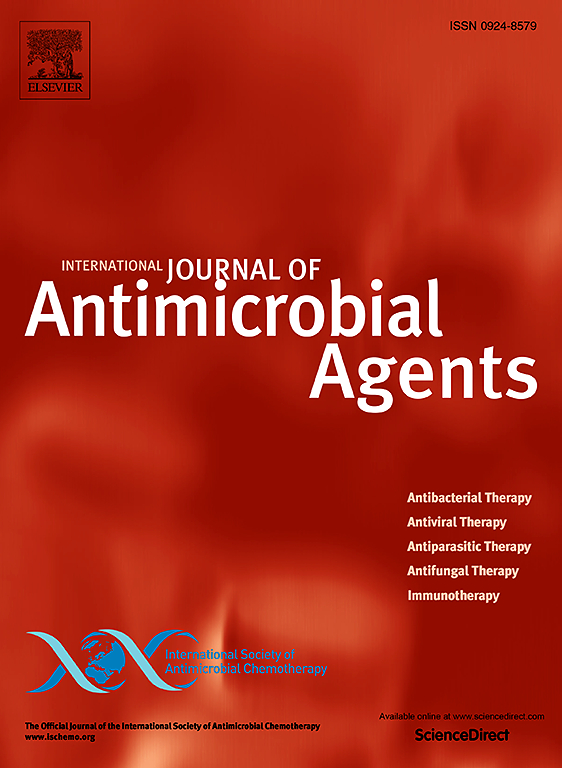在同一质粒上共携带blaNDM-5和mcr-1.1的临床耐碳青霉烯大肠杆菌的出现
IF 4.9
2区 医学
Q1 INFECTIOUS DISEASES
International Journal of Antimicrobial Agents
Pub Date : 2025-03-24
DOI:10.1016/j.ijantimicag.2025.107495
引用次数: 0
摘要
大肠杆菌是一种主要病原体,耐碳青霉烯类大肠杆菌(CREC)的出现严重限制了临床治疗选择。多粘菌素被认为是CREC感染的最后一线治疗;然而,耐多粘菌素的CREC的发生,特别是在质粒介导的粘菌素耐药(mcr)的报道之后,提出了越来越大的挑战。在这项研究中,我们从血液学病房住院患者的直肠拭子中分离出一种耐多粘菌素的CREC菌株。该菌株对除替加环素外的所有抗微生物药物均表现出耐药性。通过S1-PFGE、Southern blot分析和全基因组测序(WGS),发现该菌株携带1个mcr-1.1基因拷贝和2个blaNDM-5基因拷贝。其中一个blaNDM-5和mcr-1.1基因位于一个质粒(pCDE2901_MCR-NDM)上,另一个blaNDM-5基因位于另一个质粒(pCDE2901_NDM)上。pCDE2901_MCR-NDM中的blaNDM-5基因可能是通过转座子从pCDE2901_NDM中转移出来的。鉴于多粘菌素在治疗CREC感染中的关键作用,多粘菌素与碳青霉烯类耐药的共同转移可能严重影响临床治疗的效果。加强监测和监测对于遏制广泛耐药病原体的传播至关重要。本文章由计算机程序翻译,如有差异,请以英文原文为准。
Emergence of a clinical carbapenem resistant Escherichia coli co-harboring blandm-5 and mcr-1.1 on the same plasmid
Objectives
Escherichia coli is a major pathogen, and the emergence of carbapenem-resistant E. coli (CREC) significantly restricts clinical treatment options. Polymyxins are considered the last-line treatment for CREC infections; however, the occurrence of polymyxin-resistant CREC, particularly following reports of plasmid-mediated colistin resistance (mcr), poses an increasing challenge.
Methods
In this study, we identified a polymyxin-resistant CREC strain isolated from the rectal swab of a patient hospitalized in a hematology ward. Antimicrobial susceptibility testings, S1-PFGE, Southern blot analysis, Conjugation Experiment, whole genome sequencing (WGS) and bioinformatic analysis were used to characterize the strain.
Results
The strain showed resistance to all tested antimicrobial agents except tigecycline. By bioinformatic analysis, the strain was found to carry one copy of the mcr-1.1 gene and two copies of blaNDM-5 genes. One blaNDM-5 and the mcr-1.1 gene were co-located on a plasmid (pCDE2901_MCR-NDM), while the second blaNDM-5 gene resided on another plasmid (pCDE2901_NDM). The blaNDM-5 gene in pCDE2901_MCR-NDM was likely mobilized from pCDE2901_NDM via a transposon. The plasmid pCDE2901_NDM could successfully transferred from the donor strain CDE2901 to the recipient strain EC600, while the plasmid pCDE2901_MCR-NDM was unable to undergo horizontal transfer despite harboring mobile-associated genes.
Conclusions
Given the critical role of polymyxins in treating CREC infections, the co-transfer of polymyxin and carbapenem resistance may severely undermine the efficacy of clinical therapies. Strengthened surveillance and monitoring are imperative to curtail the spread of extensively drug-resistant (XDR) pathogens
求助全文
通过发布文献求助,成功后即可免费获取论文全文。
去求助
来源期刊
CiteScore
21.60
自引率
0.90%
发文量
176
审稿时长
36 days
期刊介绍:
The International Journal of Antimicrobial Agents is a peer-reviewed publication offering comprehensive and current reference information on the physical, pharmacological, in vitro, and clinical properties of individual antimicrobial agents, covering antiviral, antiparasitic, antibacterial, and antifungal agents. The journal not only communicates new trends and developments through authoritative review articles but also addresses the critical issue of antimicrobial resistance, both in hospital and community settings. Published content includes solicited reviews by leading experts and high-quality original research papers in the specified fields.

 求助内容:
求助内容: 应助结果提醒方式:
应助结果提醒方式:


